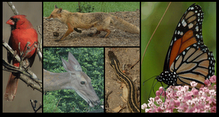On the Road in Texas - Henderson Drive Habitat



Wildlife observations from a suburban backyard adjacent to the Colvin Run Mill Park in Vienna, Virginia. Click on photos to enlarge.



Posted by
Gil Miller
at
11:30 AM
1 comments
![]()
Some photos of black vultures doing what they do best - cleaning up road kill.


Posted by
Gil Miller
at
11:17 PM
0
comments
![]()
I am on the road in Texas and thought that I would use this opportunity show some photos from a previous Texas visit.





Posted by
Gil Miller
at
12:36 PM
4
comments
![]()
These are photos of a pearl crescent butterfly that recently visited the Colvin Run Habitat.

Posted by
Gil Miller
at
5:00 PM
0
comments
![]()
Labels: Butterfly




Posted by
Gil Miller
at
6:10 PM
0
comments
![]()
Labels: Eastern Gray Squirrel


Posted by
Gil Miller
at
12:01 AM
0
comments
![]()
Labels: Northern Cardinal



Posted by
Gil Miller
at
12:01 AM
2
comments
![]()
Labels: Slug

This work is licensed under a Creative Commons Attribution-NonCommercial 3.0 License.
